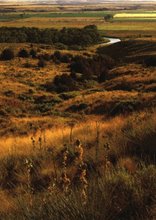
Calloway, Colin G. One Vast Winter Count: The Native American West Before Lewis and Clark, Lincoln: University of Nebraska Press: 2006.
In his book One Vast Winter Count: The Native American West before Lewis and Clark, Colin Calloway takes on the massive task of writing a history of America as Indian country. The author argues that the Native American west is best understood as an area of conflict and change. To explain his argument, Calloway discusses many of the causes of conflict and change in Native American societies before 1800, including: the environment, new forms of agriculture, new economic and political systems and their effect on the culture of indigenous people, and interaction with Europeans. From each of these changes, conflicts emerged for indigenous peoples. The act of crossing the land bridge to North America caused many Indians to adopt new subsistence tasks and to create economies and political organization. The adoption of corn by early Mesoamericans also resulted in vast cultural and religious changes for many people; Calloway discusses all of these issues as he builds a chronological narrative to 1804.
Calloway utilized a small amount of primary sources for this monograph, mostly collected letters of early Spanish and French colonists that have been published in large, multi-volume collections. That is not to say that his work is lacking in documentation; the strength of Calloway’s evidentiary base is in his synthesis of a staggering amount of secondary sources. From this mass of secondary sources, Calloway has created a highly readable account of America as Indian country up to the year 1804. Because of his focus on the west before the Lewis and Clark expedition, the author has created something more than a simple retelling of events through the use of secondary sources. Calloway has written a book that, unlike the efforts of previous historians, does not hurry through a brief sketch of Native American history so that the “real” history of the American West can be told from 1804 to the present. That is the true importance of this work.
The author focuses on conflict and change over time to showcase the rich and detailed history of the American West. While discussing themes related to conflict and change and their impact on Indians, Calloway also builds a chronological history from the ancient beginnings of the indigenous people of this continent to the year 1804, when Lewis and Clark began their expedition to the west. The book is divided into three parts, and each of these parts is divided into a set of chapters, and each chapter is again divided into brief sections that explain the causes of the many conflicts and changes experienced by Indians in the west.
Calloway’s desire to write a history of the American West beginning with and largely dedicated to the study of Native Americans is the biggest strength of this book. His use of a large amount of well-documented sources and an easily accessible collection of endnotes also make this work impressive. It was interesting to read many of the ideas of current researchers in Calloway’s book, especially the concept of Richard White’s “middle ground” and Eric Hinderaker’s ideas about competing empires in the Ohio Valley. At times this book seemed to be a sequel to Daniel Richter’s Facing East From Indian Country, a book that does for eastern United States Indians what Calloway has done for those of the west.
The weaknesses of this book are few. At times it seemed as if Calloway forgot to use commas in sentences, which made their meaning somewhat unclear. Mistakes of that nature are trivial, though. A bibliographic essay at the end of the book would have been nice, as would a list of some of the best books on the subjects Calloway discussed in this book, including: the fur trade, epidemic diseases, Native American economies and trade routes, etc.



No comments:
Post a Comment